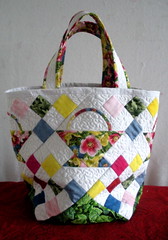 William Morris said, "Have nothing in your house that you do not know to be useful, or believe to be beautiful." I think this quilted tote bag qualifies as a nice-to-have on both counts.
William Morris said, "Have nothing in your house that you do not know to be useful, or believe to be beautiful." I think this quilted tote bag qualifies as a nice-to-have on both counts.Do you have orphan blocks–blocks you made and loved but for which you have no project in mind? Then you might consider making a useful, beautiful tote bag of your own.
This bag is approximately 12 inches high and 16 inches wide (at the top edge). The bottom is 8 inches square. It is constructed from 6 1/2-inch pieced quilt blocks and squares of fabric. (In the assembled bag, they will finish at 6 inches.) It is based on Gay's So Sew Easy Schlep Bag pattern, which you can download from the linked page on her Sentimental Stitches site. My Summer Tote differs in the following ways:
- It's based on smaller squares and uses pieced quilt blocks in place of squares.
- It is layered with batting and quilted
- It does not have a separate lining, the quilted sections are self lined by the backing fabric and the seams are covered with bias fabric.
- The straps are shorter and are constructed of two fabrics. They are attached to more than the edge of the bag.
CONSTRUCTING THE BAG
- Start with 4 blocks you want to feature. Your blocks will appear as if they are set on-point in the finished bag. If you want to make 6-inch (finished size) stamp basket blocks like mine, you can find the pattern on the About Quilting site, here.

- Add 4 more same-sized blocks that will appear at the bottom of the bag. I made 16-patch blocks in coordinating colors. Directions here.
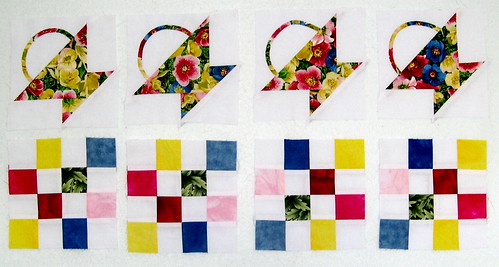
- Since the blocks you add at the bottom will, for the most part, become the bottom of the bag, I chose to use plain fabric squares, cut at 6.5 inches of a darker coordinating fabric.
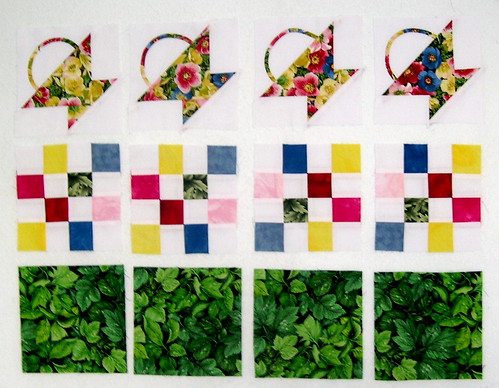
- At the top, add the half-blocks which, along with your featured blocks, will appear at the top of the bag. You could cut two pieced blocks diagonally in half. I constructed "half" 16-patch blocks and used whole squares (knowing they would be later trimmed to triangles) to prevent stretching until I was ready to finish the top edge of the bag.
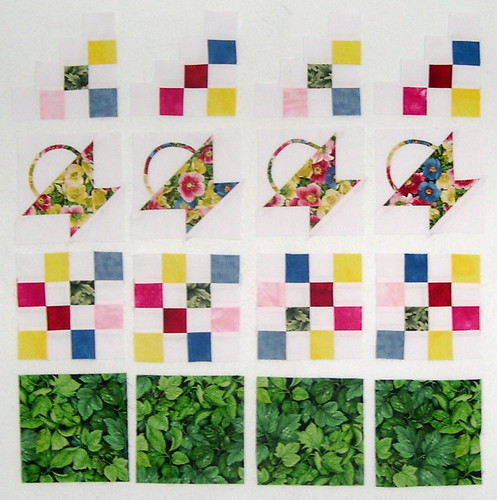
- Sew each column of blocks together, creating 4 vertical strips.

- Layer the individual strips with batting and backing (cut larger all the way around) and quilt as desired. These small strips are easy to maneuver and a great opportunity to play with free motion quilting.

There is an (unfortunately over-exposed) detail photo of the quilting here.
- Trim the quilted pieces.
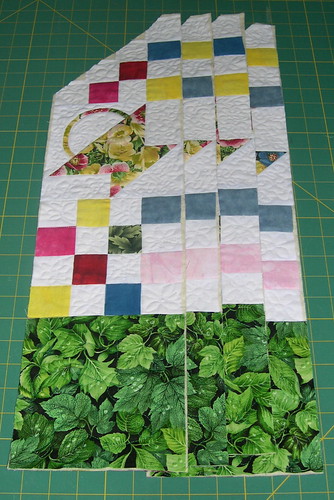
- Lay out the pieces to form a windmill like mine and stitch the 4-patch in the middle together.

- Fold the bag so the long edge of the strip is aligned with the adjacent edge, right sides together. (there is an illustration of this in the So Sew Easy Schlep Bag instructions linked above.) Repeat for each strip. The bag, inside out, will look like this.
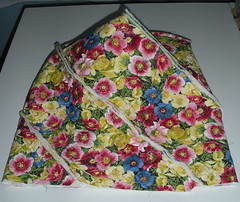
- I bound the edges on the inside of my bag for a clean finish, since the quilted bag does not require a separate lining. I had a package of double fold bias tape in a coordinating green, so I decided to use it. It was a struggle and I don't recommend it. NEXT time, I'll cut my own binding strips and they will be wider. You might decide to add a lining (so you can add interior pockets); if so, you also might decide that it's not necessary to bind the interior seams.
- Trim the top edge, if necessary, and bind. I used a 2" strip for a 1/2 inch bond edge.

I sewed the binding to the inside first, stitching it from the outside to make sure I didn't lose any of the pieced squares' corners. Then I folded it to the front, turning under 1/2 inch and used a decorative stitch to sew it in place.
- Make and attach the straps. Weather you use the directions for the Schlep bag or follow mine below, before you cut anything, decide for yourself how long the straps should be. We all have different preferences–do you want "handles" or a shoulder strap? Measure a tote bag you have and love or use your bag and a measuring tape to come up with your personalized measurement.
TWO-FABRIC STRAPS
I liked the white background of my bag, but worried that white straps would be impractical and, like the William Morris quote at the top of this post, I wanted a tote that I thought to be beautiful and knew to be USEFUL. I decided to combine the white background fabric with the print.
CUTTING
- The white fabric was cut 1-1/2 inch wide and as long as my desired strap length plus 3 inches, doubled (for two straps). In my case, this translated to almost a width of fabric for both straps. The finished straps will be this width (1-1/2 inches).
- The print fabric was cut 2 inches wide and the same length. You'll need two strips for each strap. (In my case, 2 widths of fabric).
- Batting was cut at 1-1/2 inch wide and slightly shorter for each strap
SEWING
- Sew a print (2 inch) strip to each long edge of the white (1-1/2 inch) strip. Press seams toward the print fabric on each side.
- Turn under 1/4 inch of the long edge of the print fabric on ONE SIDE ONLY.
- With the straps laying wrong side up, lay the batting in place–it should fit on top of the white fabric exactly, with a little "bade" space on each end.
- Fold the print fabric (without the pressed under edge) over the batting. If you are using fusible batting, you can fuse it in place now.
- Fold over the remaining side (with the pressed under edge) and pin in place.
- Stitch the second side down. Depending on your plans for additional stitching (to add body and strength to the straps), you could simply stitch it down by machine and add more parallel lines of stitching to the straps. I decided that would add some free-motion quilting to my straps in the middle and stitch in the ditch on each long side, so I slip stitched mine in place.



- Fold over and stitch each end. I wasn't concerned about "neat" and used a zig-zag.
- Position your straps and attach them to the bag. Unlike the Schlep bag, I did not simply sew the end of the strap to the sewn edge at the top of the bag. I knew I would be using this bag for books, groceries, and trips to the Dallas Farmer's Market and wanted to be sure the straps were attached. On my bag, each strap extends inside the bag 1-1/2 inches and is attached to the bag along that inch and a half length. You might decide to attach your straps to the outside and cover the extra stitching with a coordinating appliqué.
I machine stitched mine, basically following the stitching on the bag to make it less obvious from the outside, which meant I restitched along the line where the binding was attached to the top edge of the bag and did a generous amount of stippling beneath that in the white squares where the strap is attached to the bag. In this case, more stitching gives those handles more structural integrity.



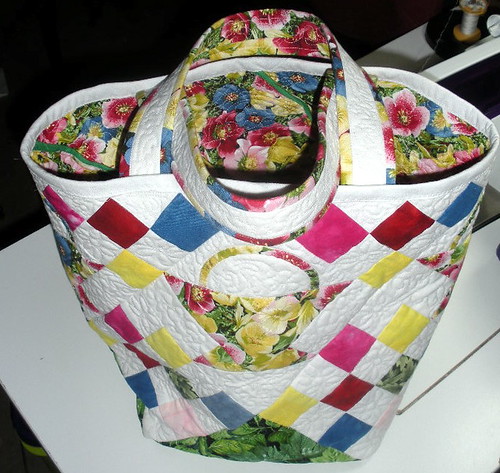
Since this initial posts, a few friends (from the block lotto and the Lib-quilters yahoo group) have made totes of their own. Read more about these lovelies in the Gallery.


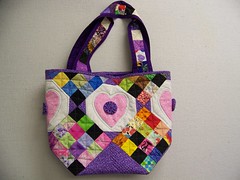
12 comments:
Wow is that cute! And a great tutorial, too! I'll make one or five, I'm sure!
Thanks for the tutorial, Sophie. I like your "wonkifing" directions too.
Kathleen C. in CT
I've never seen a bag constructed in that 'windmill' fashion before. Very nice. I especially like your two-tone handles. Kathie L in Allentown
Thanks, guys. I really like the way this bag reacts when you use it. Because it has that nice square bottom, when I set it down at the farmers' market (so I can pull my wallet out of my bag to pay for my purchases), it doesn't flop over like other bags might. I've never seen straps like that either, but it seemed to me like the best way to keep the light feeling in the bag without making impractical (for me) white straps.
It looks like the straps are hand-sewn in, is that right? (I don't see any seams on the outside of the bag.) It's beautiful!
Thanks for asking, Linda. I realize I didn't describe that and I've gone back to include it.
I actually machine stitched the straps to the bag, basically following the existing stitching on the bag to make it less obvious from the outside. I restitched along the line where the binding was attached to the top edge of the bag and did a generous amount of stippling beneath that in the white squares where the strap is attached to the bag.
In this case, more stitching gives those handles more structural integrity. Mine is a little ugly on the inside (because I didn't switch the white bobbin thread) but, it is secure.
Thank you so much. I am printing this for myself and my mom. Love the bi-color handles.
too too cute. This is my weekend project ! Thanks so much
Thanks for a great tutorial that even an 'advanced beginner' like myself can follow! This bag is darling.
I made this bag using your instructions and I love it and get compliments!!
Thanks
Kathy
beautiful - thank you for the tutorial - Deanna - Skinfizzical.com
Good-bye orphans, hello new bag!!! Super cute, fast and easy!
Post a Comment